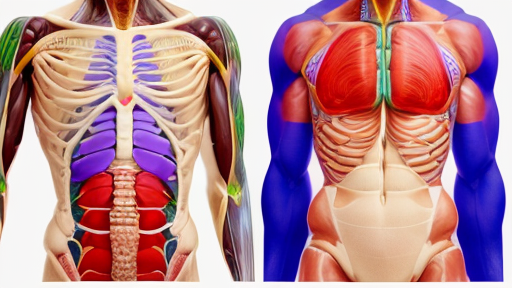Understanding Myofascia Anatomy: A Comprehensive Guide
Understanding Myofascia Anatomy: A Comprehensive Guide
Welcome to this comprehensive guide on understanding the anatomy of myofascia! If you’re curious about how your body’s fascia works and its role in your overall health and well-being, you’ve come to the right place. In this guide, we’ll delve into the intricacies of myofascial anatomy, exploring its composition, functions, and how it affects your body.
What is Myofascia?
Myofascia is a complex web of connective tissue that surrounds and supports every muscle, bone, nerve, blood vessel, and organ in your body. It’s like a spiderweb that weaves its way through your body, providing structural support and allowing for smooth movement. Myofascia is made up of collagen, elastin, and other proteins, and it plays a crucial role in maintaining the integrity of your body’s structure.
The Composition of Myofascia
Myofascia is composed of two main components: fascia and muscle tissue. Fascia is the dense, fibrous connective tissue that forms a continuous network throughout your body, enveloping and interconnecting all of your muscles, bones, organs, and other structures. Muscle tissue, on the other hand, is made up of individual muscle fibers that contract and relax to produce movement.
Fascia is made up of different layers, including the superficial fascia that lies just beneath the skin, the deep fascia that surrounds muscles, and the visceral fascia that wraps around organs. These layers work together to provide support, stability, and flexibility to your body.
Functions of Myofascia
Myofascia serves several important functions in your body. Here are some of the key roles it plays:
-
Support and Stability: Myofascia provides support and stability to your body’s structures, helping to maintain their shape and integrity. It acts like a scaffolding, providing a framework for your muscles, bones, and organs to function properly.
-
Flexibility and Movement: Myofascia allows for smooth movement of your muscles and joints. It acts like a lubricant, reducing friction between tissues and enabling them to glide smoothly over each other during movement.
-
Shock Absorption: Myofascia helps to absorb shock and distribute forces evenly across your body, reducing the risk of injury to your muscles, bones, and organs.
-
Transportation: Myofascia provides pathways for blood vessels, nerves, and other structures to pass through, facilitating communication and transportation of nutrients and waste products throughout your body.
-
Protection: Myofascia acts as a protective barrier, helping to shield your muscles, bones, and organs from external trauma and damage.
The Importance of Myofascial Health
Maintaining optimal myofascial health is crucial for overall well-being. When myofascia becomes tight, restricted, or inflamed, it can result in a range of issues, such as pain, stiffness, limited mobility, and decreased performance. Poor myofascial health can also contribute to postural imbalances, muscle imbalances, and chronic conditions like fibromyalgia.
It’s essential to keep your myofascia in good condition through regular movement, stretching, and self-care practices such as massage, foam rolling, and other myofascial release techniques. By keeping your myofascia healthy, you can optimize your body’s structure, function, and performance.
Myofascial Anatomy and Exercise
Exercise plays a significant role in maintaining healthy myofascia. Regular physical activity helps to improve circulation, flexibility, and overall tissue health, which can benefit your myofascia. Different types of exercise, such as stretching, strength, training, and aerobic exercise, can have specific effects on your myofascial anatomy:
-
Stretching: Regular stretching can help improve the flexibility and elasticity of your myofascia. Static stretching, dynamic stretching, and proprioceptive neuromuscular facilitation (PNF) stretching are some common stretching techniques that can target different layers of fascia and help maintain their optimal health.
-
Strength training: Resistance training can help build muscle strength and improve the integrity of the fascia that surrounds and supports the muscles. By engaging in regular strength training exercises, you can help promote the growth and maintenance of healthy muscle tissue and the surrounding fascia.
-
Aerobic exercise: Cardiovascular exercises like running, cycling, or swimming can improve blood circulation, which in turn promotes better oxygen and nutrient delivery to the myofascial tissues. This can help maintain their health and function optimally.
-
Postural awareness: Maintaining good posture during exercise and everyday activities can help prevent myofascial imbalances and dysfunction. Being mindful of your posture and making necessary adjustments can help minimize unnecessary strain on your fascia and maintain its health.
-
Rest and recovery: Adequate rest and recovery between workouts are crucial for allowing your myofascial tissues to repair and regenerate. Make sure to include rest days in your exercise routine and prioritize proper sleep and nutrition to support optimal myofascial health.
In conclusion, understanding the anatomy of myofascia and its functions is essential for maintaining overall health and well-being. Incorporating regular exercise, proper posture, rest, and self-care practices into your routine can help promote healthy myofascial tissues and optimize their function. Consult with a healthcare professional or a qualified fitness expert to develop a well-rounded exercise program tailored to your specific needs and goals. Take care of your myofascia, and it will take care of you!
You may like this video!
